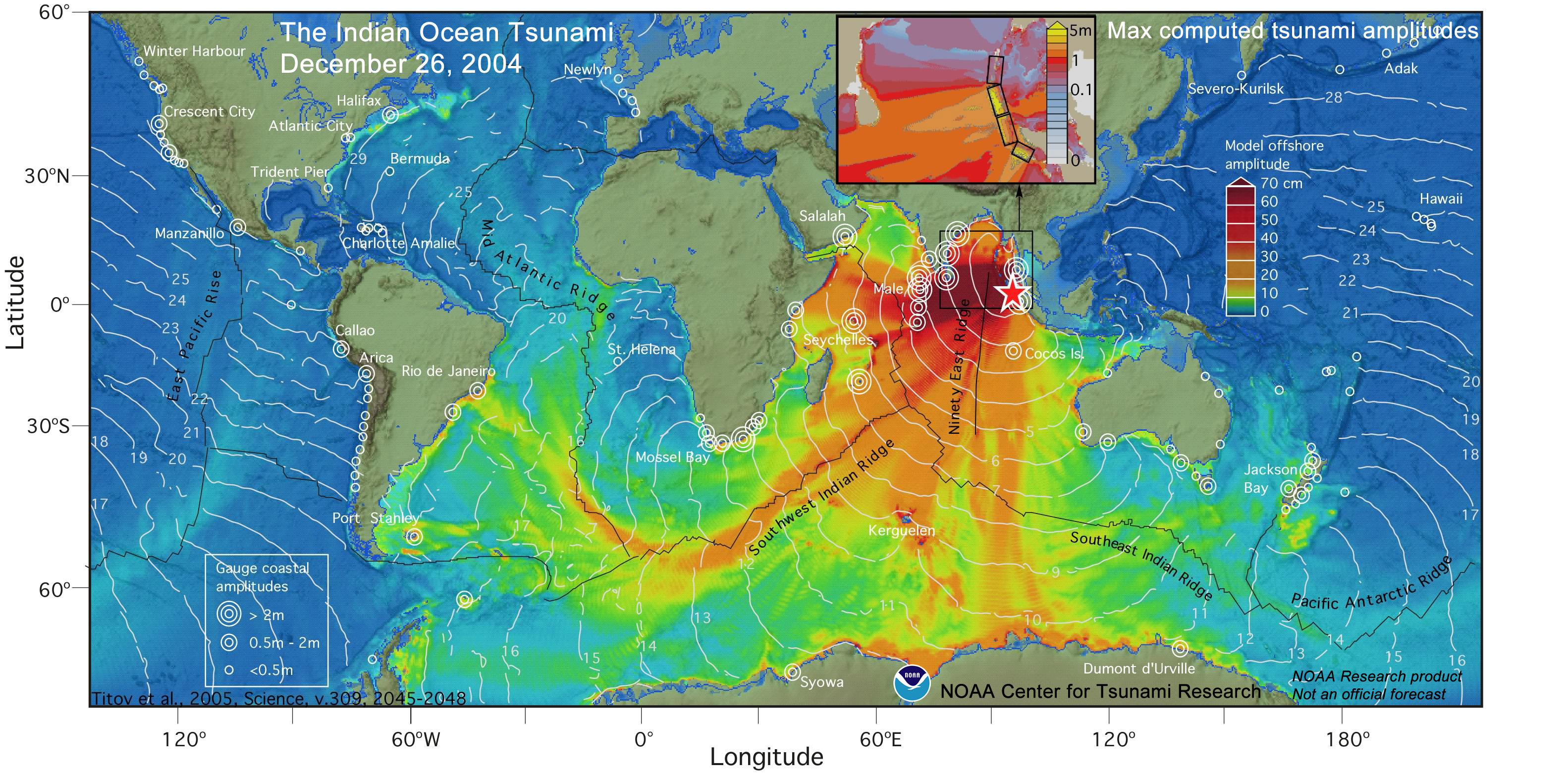Not an official forecast
Tsunami Event - The Indian Ocean Tsunami, December 26, 2004
Main Event Page
Indian Ocean Event Page | Compilation of Web Links and Data
The Indian Ocean tsunami was generated by a Mw 9.1 earthquake (3.295°N 95.982°E), 2004-12-26 00:58:53 UTC, off the west coast of northern Sumatra (according to the USGS). Forecast results shown below were created with the NOAA forecast method using MOST model with the tsunami source inferred from tsunameter/DART® data.
The graphics display research forecast results, showing qualitative and quantitative information about the tsunami, including tsunami wave interaction with ocean floor bathymetric features, and neighboring coastlines. Tsunami model amplitude information is shown color-coded according to the scale bar. See information on MOST model.
Modeling Results
Tsunami Propagation
- Download global tsunami propagation animation 7.24 MB .mp4 (2008.04.23)
- The 2004 Indonesian Tsunami, visualization of the MOST model (NESDIS)
Tsunami Amplitudes
- Maximum computed tsunami amplitudes around the globe (image)
- Maximum computed tsunami amplitudes in the Indian Ocean (PDF)
- Tsunami amplitude in the southeastern Pacific Ocean (PDF, Rabinovich, et al. 2017)
Tsunami Arrival Times
- Computed tsunami arrival times in the Indian Ocean (PDF)
- Computed tsunami arrival time from the global tsunami propagation model (image)
- Observed wave arrival times (Source: WC/ATWC, India National Institute of Oceanography) (image)
- Comparison of observed wave arrival times with modeled simulations (image)
- Tsunami travel times in the southeastern Pacific Ocean (PDF, Rabinovich, et al. 2017)
- Tsunami 7:10 hours after Earthquake: Plot (PDF format) & Data (ASCII)
- Tsunami 2:00 hours after Earthquake: Plot (PDF format) & Data (ASCII)
- Tsunami 3:15 hours after Earthquake: Plot (PDF format) & Data (ASCII)
- Tsunami 2:05 hours after Earthquake: Plot (PDF format) & Data (ASCII)
References:
- WHF Smith, R Scharroo, VV Titov, D Arcas, BK Arbic (2005): Satellite Altimeters Measure Tsunami. Oceanography Vol.18, No.2, June 2005. Download: PDF
- The altimetry data is courtesy of Remko Scharroo (Remko.Scharroo@noaa.gov) and Water Smith (walter.hf.smith@noaa.gov), NOAA, Laboratory for Satellite Altimetry, Silver Spring, MD, USA.
- Satellite Altimetry Database System at the Department of Earth Observation and Space (DEOS) Systems of the Faculty of Aerospace Engineering at Delft University of Technology, the Netherlands.
Bottom Pressure Recorder (BPR) Data
14 days of 15-second bottom pressure and temperature data (~80k lines each)
- nemo_sumatra.txt (ASCII data) & nemo_sumatra_meta.doc (ASCII metadata)
- Latitude 45 51’ 40” N, Longitude 130 00’ 00” W; Start: 23 December 2004 00:00:00 UT, End: 6 January 2005 00:00:00 UT
- 46405_sumatra.txt (ASCII data) & 46405_sumatra_meta.doc (ASCII metadata)
- Latitude 42 54’ 11” N, Longitude 130 54’ 32” W; Start: 23 December 2004 00:00:00 UT, End: 6 January 2005 00:00:00 UT
Unit Sources: 2*(io10y + io10z + io11a+ io11y) + 14.25*(io12a + io12y + io12z + io13y + io13z + io14a + io14y + io14z + io15a + io15y + io15z) + 10.9*(io16a + io16z + io17a + io17y + io17z + 1018a + io18y+io18z + io19a + io19y + io19z) + 21*(io20a + io20y + io20z + io21a + io21y + io21z + io9a + io9y + io9z)
DART (Deep-Ocean Assessment and Reporting of Tsunamis) - Buoys for early detection and real-time reporting of tsunamis in the open ocean.
Other Sources of Information
- NOAA Reacts Quickly to Indonesian Tsunami - NOAA News
- NOAA Scientists Able to Measure Tsuniami Height from Space - NOAA News
- National Tsunami Hazard Mitigation Program Archives
- International Tsunami Information Center
- More Tsunami Links
References
Arcas, D., and V. Titov (2006): Sumatra tsunami: lessons from modeling. Surv. Geophys., 27(6), doi: 10.1007/s10712-006-9, 679–705.
Geist, E.L., V.V. Titov, D. Arcas, F.F. Pollitz, and S.L. Bilek (2007): Implications of the 26 December 2004 Sumatra–Andaman Earthquake on tsunami forecast and assessment models for great subduction-zone earthquakes. Bull. Seis, 97(1A), doi: 10.1785/0120050619, S249–S270.
Geist, E.L., S.L. Bilek, D. Arcas, and V.V. Titov (2006): Differences in tsunami generation between the December 26, 2004 and March 28, 2005 Sumatra earthquakes. Earth Planets Space, 58(2), 185–193.
Geist, E.L., V.V. Titov, and C.E. Synolakis (2006): Tsunami: Wave of change. Scientific American, 294(1), 56–63. Text of article from the Scientific American website.
Rabinovich, A.B., V.V. Titov, C.W. Moore, and M.C. Eblé (2017): The 2004 Sumatra tsunami in the southeastern Pacific Ocean: New global insight from observations and modeling. J. Geophys. Res., 122, 7992-8019, doi: 10.1002/2017JC013078.
Rabinovich, A.B., P.L. Woodworth, and V.V. Titov (2011): Deep-sea observations and modeling of the 2004 Sumatra tsunami in Drake Passage. Geophys. Res. Lett., 38, L16604, doi: 10.1029/2011GL048305.
Synolakis, C.E., and E.N. Bernard (2006): Tsunami science before and beyond Boxing Day 2004. Phil. Trans. Roy. Soc. Lon. A, 364(1845), doi: 10.1098/rsta.2006.1824, 2231–2265.
Titov, V.V., A.B. Rabinovich, H.O. Mofjeld, R.E. Thomson, and F.I. González (2005): The global reach of the 26 December 2004 Sumatra Tsunami. Science, 309(5743), 2045–2048.
Disclaimer: The forecasts on these pages show the results of ongoing research to enhance tsunami science and to improve NOAA operational tsunami forecasts. These products were developed during or shortly after the tsunami event, are intended for research use, and are not an official forecast. They should not be used as the basis of any public or private policy decisions. Please contact NCTR to find if there are more detailed follow-on analysis results.
For media inquiries:
When using information from this page, please credit NOAA / PMEL / Center for Tsunami Research

